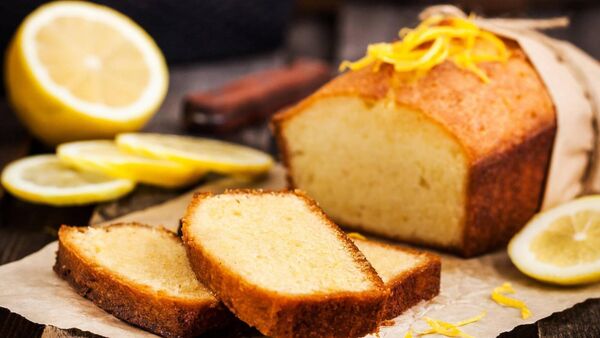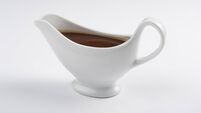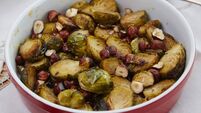Michelle Darmody: How to bake the classic lemon drizzle cake

Pic: iStock
Lemon drizzle is a classic that does not necessitate too many ingredients or too much time.
The combination of tart and sweet stickiness makes it a delicious accompaniment to a cup of tea.
The recipe here suggests a mixer, but you can just as easily beat the butter and sugar by hand, in fact it is best to stir the flour in by hand.
Beating flour can very often lead to a stiff batter that bakes into a tough cake. Sieving the flour will add air and then a mix with a wooden spoon will ensure a soft bouncy crumb to your cake.
A lemon drizzle cake keeps well in an airtight container for about four days. It is best not to store it in the fridge as it will harden.
Candied strips of lemon peel decorate the cake nicely.
Candy the peel by removing the thin yellow layer of skin with a potato peeler. Slice this very thinly into strips. Soak the strips in boiling water then drain. For each lemon that you have peeled melt 100g of sugar in 50mls of water and simmer the peel over a low heat for ten minutes. Scoop into a bowl and leave to sit until cool.
These are handy for decorating other buns and cakes as well.
Lemon Drizzle Cake
This recipe makes about eight thick slices of this perennial favourite.

Preparation Time
15 minsCooking Time
40 minsTotal Time
55 minsCourse
BakingIngredients
For the loaf cake:
4 eggs
225g self-raising flour
225g soft butter
215g golden caster sugar
zest 2 lemons
For the drizzle:
4 tbsp lemon juice
80g granulated sugar
Method
Preheat your oven to 180ºC/gas mark 4. Line a 2lb loaf tin with baking parchment.
Crack the eggs into a cup or a jug and lightly beat them with a fork until the yolks and whites are completely mixed. Set aside.
Sieve the flour and set aside.
Place the butter, sugar, and lemon zest into the bowl of a mixer and use the paddle attachment to beat it until smooth and fluffy.
Turn the mixer to low and gently add the eggs. Add a spoon of flour if you see the mixture beginning to curdle or separate.
Turn off the mixer and remove the bowl making sure to scrape any of the cake mix from the attachment. Add the flour to the bowl and mix it into the cake batter with a wooden spoon.
Scoop the mixture into your prepared loaf tin. Smooth the top of the batter with the back of the spoon.
Place the tin into the centre of your heated oven and bake for 40 minute or until a skewer comes out clean when inserted into the centre of the cake.
Towards the end of baking make your drizzle by stirring the sugar and lemon juice together.
Once you remove the cake from the oven prick it all over with your skewer. If you do not have a skewer, you can use a fork. Pour the drizzle over the warm cake and allow it to sink in.
Allow the cake to cool in the tin.
- If your cake dips in the centre, it was most likely not baked for long enough or the oven door had been opened before the cake had set. Even when you are testing the cake after the 40 minutes just slide the oven shelf out and test the cake quickly with a skewer rather than removing the cake from the oven.
- It is advisable to add the drizzle while the cake is still quite warm for the best result. The syrup will soak into the cake and leave a sugar crust on top. Do not take the cake out of the tin until it has cool completely to allow the syrup to set into the sponge. If you remove it too early, it will leak out.
- If the cake is hard and dry it has probably been overbaked. This may be due to your oven being hotter than the temperature gauge is saying. To get around this you can try baking at a lower temperature the next time or you can buy a separate oven thermometer.
- If your cake feels tough it is most lightly because the flour was beaten too much. This is why it works well to add the flour with a wooden spoon rather than a mixer.
- You will get the best results if all of the ingredients are at room temperature, particularly the eggs and butter. If the eggs are too cold, they will cause the batter to split and room-temperature butter will combine with the sugar with more ease.
- If you feel the cake has not risen as much as it should, it might be worth checking the date on your bag of self-raising flour. It does not have as long a lifespan as plain flour due to the raising agent within it. If the flour is old the cake quite simply will not rise.
- To make an orange version substitute the lemon zest for the zest of two oranges and the lemon juice for orange juice. When doing this, you can reduce the sugar in the drizzle to 60g.
- For a more colourful cake add either 150g of raspberries or blueberries to the batter before scooping it into the tin.
- To make a lemon poppyseed loaf add 2 tablespoons of poppyseeds to the batter. You can omit the drizzle if you wish and instead ice the cake with an icing made of 100g of icing sugar mixed with one and a half tablespoons of lemon juice.
- To make a slightly floral version mix 2 tablespoons of elderflower cordial with 2 tablespoons of lemon juice for the drizzle. When doing this, you can reduce the sugar in the drizzle to 60g. 1 tablespoon of chopped (unsalted) pistachio nuts can be added to the batter. Decorate with some edible rose petals.









